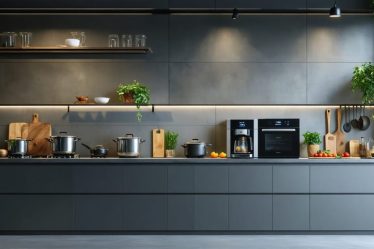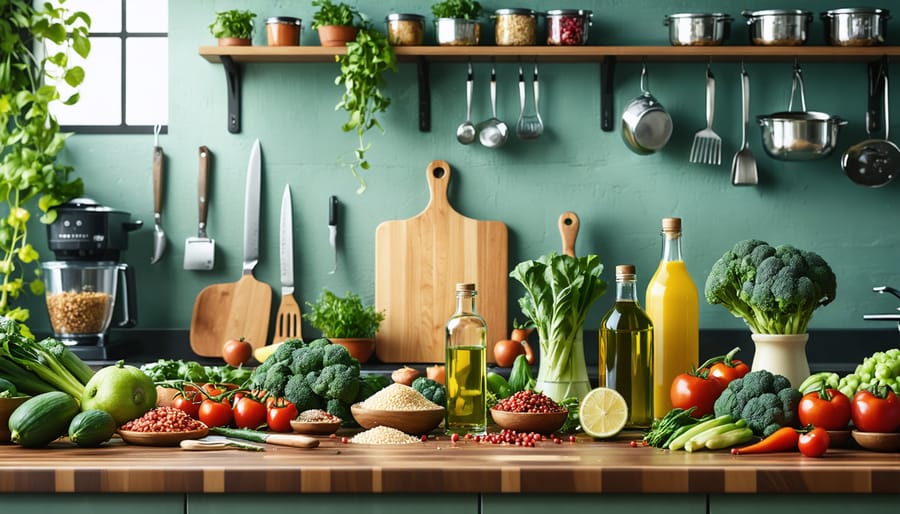
Transform your kitchen into a health-focused sanctuary by mastering the fundamentals of nutritious cooking – a journey that begins with understanding wholesome ingredients and ends with delicious, nourishing meals on your table. Start with stocking your pantry with versatile staples like whole grains, legumes, and heart-healthy oils, then build your confidence through simple, nutrient-rich recipes that take just 30 minutes to prepare.
Learning to cook healthy meals isn’t just about following recipes; it’s about developing a sustainable relationship with food that energizes your body and delights your taste buds. Whether you’re a complete beginner or looking to level up your cooking game, the path to healthier eating starts with practical kitchen skills and smart ingredient choices.
From mastering basic knife techniques to understanding portion control and meal prep strategies, this guide will walk you through everything you need to know to create wholesome, satisfying meals at home. By focusing on fresh, seasonal ingredients and time-saving cooking methods, you’ll discover that healthy cooking can be both accessible and enjoyable, fitting seamlessly into your busy lifestyle while supporting your wellness goals.
Setting Up Your Healthy Kitchen
Must-Have Kitchen Tools
Creating delicious, healthy meals starts with having the right essential kitchen tools at your fingertips. As someone who’s transformed my own kitchen from barely-equipped to confidently-stocked, I can tell you that you don’t need everything – just the right things!
Start with a quality chef’s knife and cutting board – these two items will handle about 80% of your prep work. Add a set of measuring cups and spoons for portion control and recipe accuracy. A large non-stick skillet and a medium-sized pot will cover most of your cooking needs, while a sheet pan is perfect for roasting vegetables.
For healthy meal prep, invest in a colander for washing produce, a vegetable peeler, and a box grater. A blender is fantastic for smoothies and sauces, while storage containers help with meal planning and keeping ingredients fresh.
Don’t feel pressured to buy everything at once! Build your collection gradually, focusing on versatile pieces that serve multiple purposes. Remember, the best tools are the ones you’ll actually use regularly.
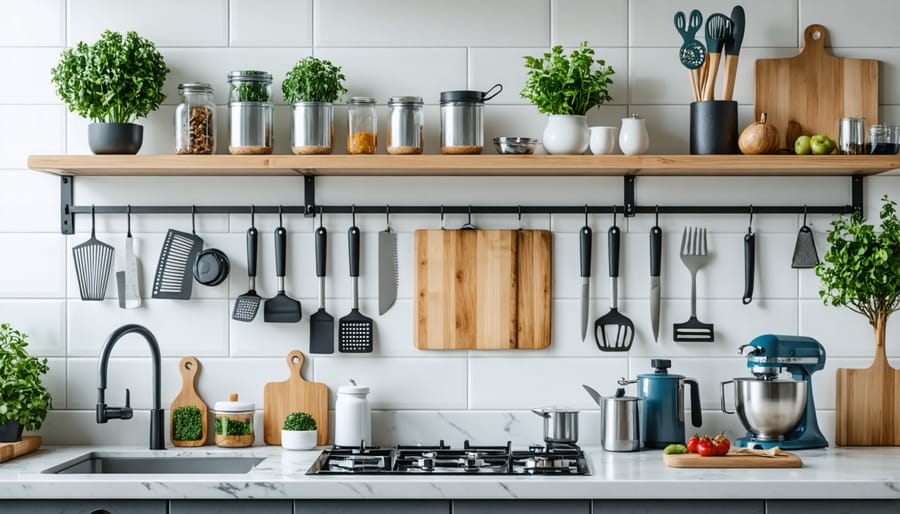
Stocking a Healthy Pantry
A well-stocked pantry is your secret weapon for creating healthy meals without last-minute grocery store runs. Trust me, I learned this the hard way after countless evenings of staring into an empty cupboard! Let’s build your healthy cooking foundation with these essential ingredients.
Start with whole grains like quinoa, brown rice, and whole wheat pasta. These fiber-rich alternatives to refined grains will keep you satisfied longer and add wonderful texture to your meals. Stock up on legumes – canned or dried beans, lentils, and chickpeas are protein powerhouses that work in everything from soups to salads.
For healthy fats, keep olive oil, avocado oil, and nuts on hand. These aren’t just better for you than processed oils; they add incredible flavor to your dishes. Speaking of flavor, build your spice collection with basics like black pepper, cumin, paprika, and garlic powder. Fresh herbs are fantastic, but dried herbs are perfect pantry backups.
Don’t forget your shelf-stable produce heroes: canned tomatoes, dried mushrooms, and sun-dried tomatoes add instant depth to dishes. For natural sweetness, stock maple syrup and honey as healthier alternatives to refined sugar.
A few convenience items can be lifesavers: low-sodium vegetable broth, canned wild-caught fish, and whole grain crackers. These make quick, nutritious meals possible even on your busiest days.
Remember, you don’t need to buy everything at once! Start with the basics and gradually build your collection as you explore new recipes. Your future self will thank you for having these healthy ingredients ready to go.
Basic Healthy Cooking Techniques
Steaming and Roasting
Let me share a little secret from my own kitchen journey: steaming and roasting vegetables completely transformed how I think about healthy cooking. These two techniques are absolute game-changers when it comes to preserving nutrients while creating incredibly flavorful dishes.
Steaming is like giving your vegetables a spa treatment – it’s gentle yet effective. Place your veggies in a steamer basket over simmering water, cover, and let the magic happen. Broccoli typically needs just 5-7 minutes, while denser vegetables like carrots might need 10-12 minutes. You’ll know they’re ready when they’re tender but still have a slight crunch. Pro tip: add a few lemon slices or fresh herbs to the water for an aromatic boost without adding calories.
Roasting, on the other hand, brings out the natural sweetness in vegetables through caramelization. I love how it turns ordinary Brussels sprouts into crispy, golden treats! Preheat your oven to 400°F (200°C), toss your chosen vegetables with a light drizzle of olive oil and your favorite seasonings, then spread them on a baking sheet. Most vegetables take 20-30 minutes, but keep an eye on them and give them a shake halfway through.
Both methods are incredibly versatile and require minimal added fats while maintaining those precious nutrients. I especially love batch-roasting vegetables on Sunday evenings – it’s such a relaxing way to prep for the week ahead, and the leftovers are perfect for quick lunch bowls or dinner side dishes.
Remember, the key to success with both methods is not overcooking. You want your vegetables to maintain their vibrant colors and a bit of texture – nobody enjoys mushy vegetables!
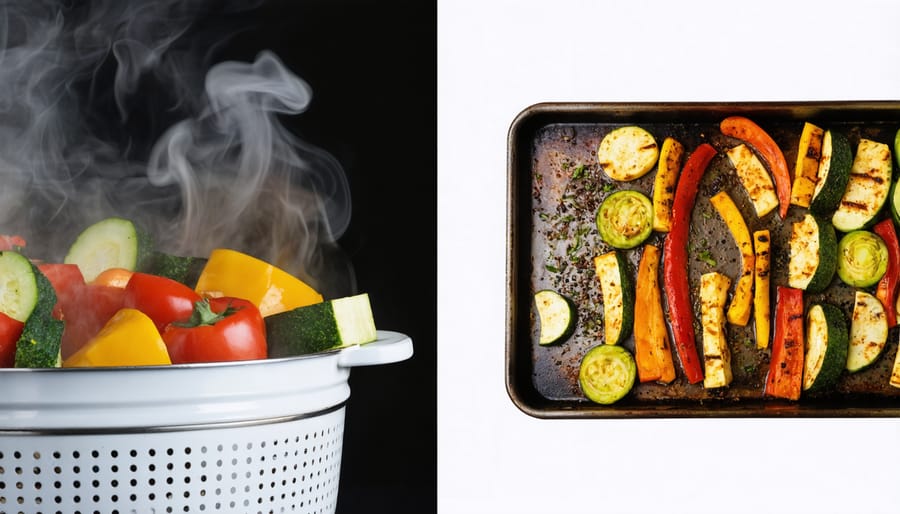
Healthy Protein Preparation
Let’s talk about making those proteins work for your health goals without sacrificing flavor! I remember when I first started cooking healthier meals, I thought lean proteins meant endless plates of bland chicken breast. Trust me, there’s a much better way!
Start by choosing your lean proteins wisely. Chicken breast, turkey, fish, tofu, and legumes are all fantastic options that won’t break the calorie bank. The key is in the preparation – you don’t need loads of oil or butter to make these proteins taste amazing.
For chicken and turkey, try marinating them in citrus juices, herbs, and a touch of olive oil for 30 minutes before cooking. This keeps the meat juicy while adding tons of flavor. My go-to marinade combines lemon juice, garlic, rosemary, and just a tablespoon of olive oil for four servings.
When it comes to cooking methods, broiling, grilling, and baking are your best friends. These techniques require minimal added fats while creating delicious caramelization. For fish, try wrapping it in parchment paper with herbs and lemon slices – this steam-baking method keeps all the moisture and flavors locked in.
Don’t forget about plant-based proteins! Tofu can be absolutely delicious when you press it first (to remove excess moisture) and then bake or air-fry it with your favorite seasonings. Legumes like lentils and chickpeas can be transformed into satisfying meals with the right spices and herbs.
Pro tip: Keep a spray bottle filled with olive oil for controlled portions when cooking. This helps you use just enough fat to prevent sticking while keeping the meal healthy.
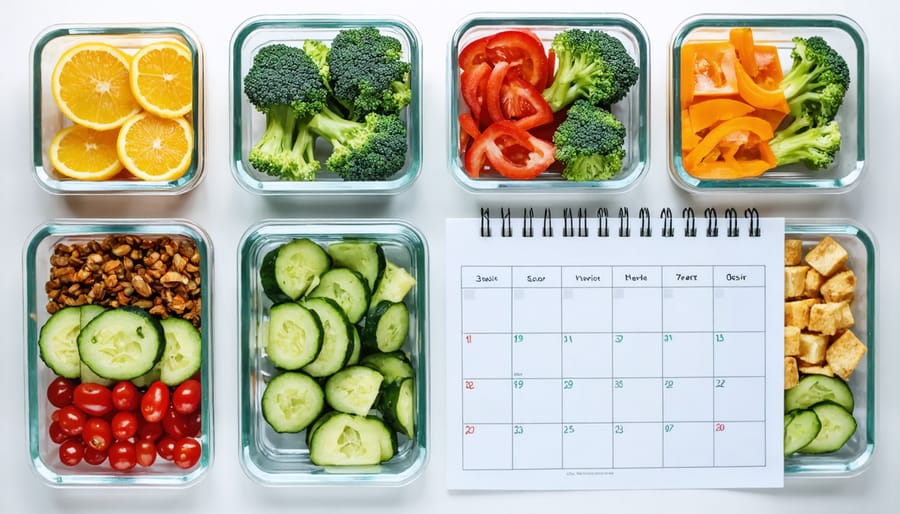
Meal Planning Made Simple
Weekly Planning Strategies
Getting organized is half the battle when it comes to healthy cooking, and I’ve found that a solid weekly plan can turn chaos into calm. Start by setting aside 30 minutes every weekend for planning – trust me, this small investment saves hours during the week!
Choose 4-5 main dishes you’d like to cook, keeping in mind which ingredients can work double-duty across multiple meals. For instance, roasted vegetables can accompany Monday’s chicken and Tuesday’s grain bowl. I love keeping a digital note on my phone with meal ideas, making it easy to build my weekly menu.
Create your shopping list by category: produce, proteins, pantry items, and extras. This approach prevents those dreaded multiple store trips and helps you stick to your budget. Pro tip: check your pantry before shopping – you might already have some ingredients hiding in there!
Consider prep-ahead opportunities. Maybe Sunday afternoon becomes your veggie-chopping party (I put on my favorite podcast and make it fun!). Washing and cutting produce in advance makes weeknight cooking so much smoother. Store prepped ingredients in clear containers at eye level in your fridge – you’re more likely to use what you can see.
Don’t forget to plan for leftovers! Building in a “leftovers night” reduces waste and gives you a much-needed break from cooking. Keep your plan flexible – sometimes life happens, and that’s okay. The goal is progress, not perfection.
Time-Saving Prep Tips
Let me share a game-changing secret that transformed my cooking routine: dedicating just two hours on Sunday to prep can save you countless hours during the week. I’ve discovered that implementing efficient meal preparation strategies is the key to maintaining healthy eating habits without feeling overwhelmed.
Start by washing and chopping all your vegetables at once. Store them in clear containers, and you’ll have ready-to-use ingredients for quick stir-fries, salads, or roasted vegetable medleys. I like to prep rainbow containers of bell peppers, carrots, and broccoli – they’re not just practical but also bring joy to my fridge!
Batch cooking is another time-saving superstar. While you’re making dinner, double the recipe and freeze portions for later. Cook a large batch of quinoa or brown rice, grill several chicken breasts, or roast a pan of vegetables – these become building blocks for various meals throughout the week.
Consider the “cook once, eat twice” method: tonight’s grilled chicken can become tomorrow’s healthy chicken salad. Prepare versatile basics like hard-boiled eggs, overnight oats, and homemade dressing that can last all week. Keep mason jars handy for portioning out ingredients and creating grab-and-go meals.
Remember, effective prep isn’t about spending hours in the kitchen – it’s about working smarter, not harder. Start small with just a few prep tasks and gradually build your routine as you discover what works best for your lifestyle.
Smart Substitutions
Reducing Sugar and Salt
Let’s explore some delicious ways to enhance flavor while cutting back on sugar and salt in your cooking. I discovered that natural ingredients can actually make dishes taste even better than their high-sodium or sugary counterparts! For sweetness, try using ripe fruits like mashed bananas or applesauce in baking, or a touch of cinnamon which adds warmth and natural sweetness without the calories. These healthy ingredient substitutions can transform your favorite recipes into more nutritious versions.
For savory dishes, herbs and spices are your best friends. I love using fresh basil, thyme, or rosemary to add depth to my meals. Citrus zests and juices can brighten any dish while reducing the need for salt. Roasted garlic and caramelized onions create rich, complex flavors naturally. Even umami-rich ingredients like mushrooms and tomatoes can add that satisfying taste that makes you forget all about the salt shaker.
Remember, your taste buds adapt over time. Start by gradually reducing sugar and salt in your recipes, and you’ll soon appreciate the natural flavors of whole foods even more.
Healthy Fats and Proteins
When it comes to healthy fats and proteins, making smart choices can transform your meals from merely filling to genuinely nourishing. I learned this lesson when I switched from frying everything in butter to experimenting with olive oil and avocado oil – my digestion improved, and I felt more energized throughout the day!
For healthy fats, reach for options like extra virgin olive oil, avocados, nuts, and seeds. These not only add wonderful flavor but also help your body absorb essential vitamins. I love drizzling olive oil over roasted vegetables or adding sliced avocado to my morning toast.
As for proteins, consider incorporating more lean options like chicken breast, fish, legumes, and tofu into your weekly rotation. Greek yogurt and eggs are also fantastic protein sources that are incredibly versatile in the kitchen. One of my favorite meal prep tricks is keeping canned beans and frozen fish fillets on hand – they’re perfect for those busy evenings when you need a quick, healthy protein fix.
Remember, the key is balance. You don’t need to completely eliminate other fats or proteins; just make mindful choices most of the time.
Remember, your journey to becoming a confident healthy cook is a marathon, not a sprint. Every small step you take – from mastering simple vegetable prep to experimenting with new whole grain recipes – brings you closer to your goal of nurturing yourself and your loved ones with delicious, nutritious meals.
I started just like you, feeling overwhelmed in my kitchen and unsure where to begin. Now, cooking healthy meals is one of the most rewarding parts of my day, and I know you can experience that same joy and satisfaction.
Start small by choosing one new recipe to try this week. Perhaps it’s that quinoa bowl you’ve been eyeing or a colorful stir-fry packed with vegetables. Remember to be patient with yourself and celebrate your successes, no matter how small they might seem.
Join our community of home cooks by sharing your progress on social media or connecting with friends who share your healthy cooking goals. Consider starting a weekly meal prep routine or organizing a healthy recipe swap with colleagues.
The kitchen is your canvas, and healthy cooking is your creative outlet. Trust your instincts, keep learning, and most importantly, have fun with the process. Your future self will thank you for taking these first steps toward a healthier, more confident you in the kitchen.
Ready to get started? Your next delicious, healthy meal awaits!

